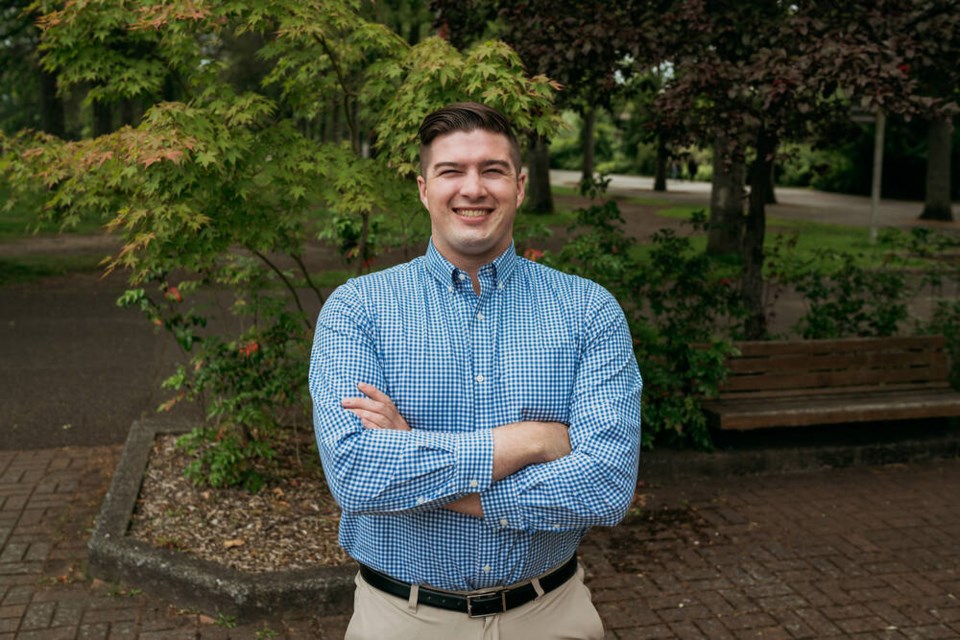Zac de Vries
Website: Zacdevries.ca
Facebook: @Zac4Saanich
Twitter: @Zacdevries
Instagram: @Zacdevries
Are you associated with or running as part of a slate? If so, which one?
No, I am an independent
Do you live in the municipality where you are running, and if so, for how long? If not, what is your connection to that community?
I have been living in Saanich for the last 27 years. I am born, raised, and educated in Saanich.
What is your occupation, and for how long?
I have been a BC Public Servant for the past 4 years and am currently a Sr. Program Developer with the Ministry of Agriculture and Food as part of the Food and Beverage Processing Team. I offer subject matter expertise and advise to the sector, teams in the Ministry, other Ministry’s and the Minister. I am also the policy lead for beverages.
Tell us about your previous elected and/or community experience.
I have been a community organizer since 2013, involved in electoral politics since 2015, and was first elected to Saanich Council in 2018. In my first term I have held various appointments: Chair of Planning Transportation, and Economic Development Committee (3 years), Chair of Saanich’s Housing Strategy Taskforce, Chair of the Mayor’s Standing Committee on Housing Affordability and Supply, Liaison to the Peninsula and Area Agriculture Commission and the University of Victoria.
Why are you running? What’s your motivation?
I’m running because I love Saanich and we’re at risk of losing what makes our community great. Too many people are struggling to create their lives here. I was raised in a neighborhood with a wide range of incomes, backgrounds, and lifestyles. This bringing together of a mix of people greatly enriched my life. I had access to a quality of life that was fulfilling and empowering; I could maximize what I did in life. I want to ensure Saanich is once again accessible to the mixture of people that are at the heart of what makes this place great.
What are your top three issues?
Housing Affordability, Sustainability (social, economic, and environmental), and Equity are the top issues facing Saanich. These issues are intertwined in the five crises of city building—climate, housing, public health, equity, and infrastructure costs. We have been challenged on how to get from vision to reality in these areas. Great cities are the product of successful plans. Success requires us to tweak, revisit, and rethink, our approaches, to deliver the outcomes that residents expect and deserve. We must adjust based on how our policies play out in complex contexts. Making Saanich more sustainable, more livable, and more equitable requires action.
What’s your vision for your community in 25 years?
Saanich is widely admired as a place that is highly livable, sustainable, and resilient. Saanich is a community that is accommodating, interesting, and contemporary—at the vanguard of Canadian Cities. Vanguard here means a Saanich that meets people’s needs and builds sustainable neighbourhoods for all. Housing is the foundation of a happy and healthy life; it is what empowers people to be creative and to maximize what they do in life, and be fulfilled. Wherever you are in Saanich there should be people living, working, playing, loving, and being together. Sustainable neighbourhoods for all creates the sense of community and vibrancy we all desire. In summary: in 25 years Saanich recognized as a model for social, economic, and environmental sustainability around the world.
What’s one “big idea” you have for your community?
It is time that the region comes together to create a Regional Transportation Authority. BC Transit and 13 municipalities are not able to efficiently deliver the level of service required for public transit to be the best transportation choice. Transit is a more effective way to move people around our communities but needs to be excellent and enjoyable experience. A Regional Transportation Authority, like TransLink, would manage roads of regional importance, land-use on these corridors, regional transportation demand management, and delivers better transit to the region. Moving land-use and transportation policy together in a careful choreography we can deliver a more livable, sustainable, resilient, and equitable region for our residents.



